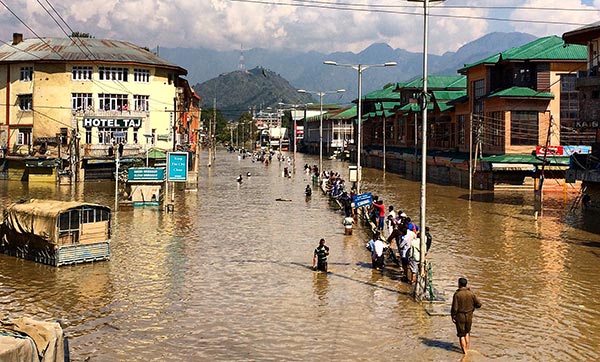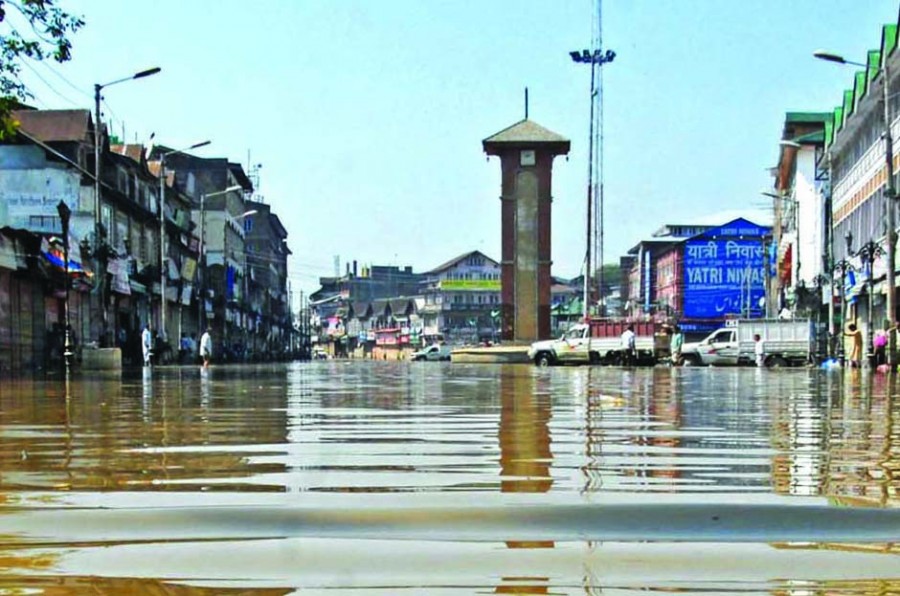In the deluge-hit Kashmir, victims counted on government for revival and rehabilitation. But a year later, both statistic and street voices seem at loggerheads with governance system, reports Bilal Handoo

After a momentous breakdown in last fall, everybody was endorsing to plug loopholes on war-footing. Jhelum had caught both people and government napping. Kashmiris, many said, responded the catastrophic call at the eleventh hour. After the shake, a sense seeped in: Jhelum attained its natural course again where a multitude of seminaries and cemeteries had shown up.
The deluged government sitting over human wreck stood upbeat. It vowed governance based on resurrection, revitalization and rehabilitation after inviting Rs 100,000 crore disaster. However, even a year later, an hour-long shower can raise hackles, thus unmasking the governance deficit in Kashmir.
While resurrecting itself after flood-induced anarchy, the government sounded like a felon, confessing how flood almost caught it red-handed. “But some lessons have been learned,” the previous government would say. Behind Omar government’s ‘guilt trip’ was its inability to act against the rampant construction that choked water bodies. By flattening human habitations like a house of cards, Jhelum demonstrated that nature indeed loves its own course. As the dust settled, the city expansion revealed itself as the key culprit.
The areas where Jhelum had run amok were Rajbagh, Kursoo, Jawahar Nagar, Gogjibagh, Wazir Bagh, Chanapora, Natipora, Bemina, Qamarwari and among others. These are the same areas which the British land settlement officer, Walter Lawrence termed a “huge flood basin” in his book, ‘Valley of Kashmir’. During 1893 flood, he writes, the huge flood basin had formed a huge lake right up to the present Badgam district.
Over the years, the city expansion only narrowed down Jhelum flood basin.

Even state revenue records don’t keep it a secret anymore, “Upscale residential areas lying left of the Jhelum are its old flood basin.” After floods, the government made an abject admission that “what was done can’t be undone”, but people at least expected a ban on constructions across low-lying areas especially in marshes and spaces nearby water bodies. Some even hoped changes in land use policy, building structures and city expansion. “But nothing changed even after the flood-hit us on our chin,” says Mushtaq Ahmad, a revenue officer. “Everybody was expecting a kind of migration from low-lying areas after floods. But we have a completely reverse picture. People are still investing in a place where Jhelum uprooted them. Even government appears at peace with this dangerous status quo.” The canvas of governance however was wider than merely keeping a tap on constructions. People were expecting erasure of encroachments on riverbanks.
But in the din of the electoral process and change of guard ‘gala’, the governance apparently hit a roadblock. It was then judiciary got involved by serving multiple notices against governance inactivity. But even judiciary couldn’t undo the glaring encroachments on riverbanks; though, for public posturing, the government quickly axed around 170000 trees on embankments.
Amid concrete monsters, serious question marks were put on government’s will. Barring few instances where JCBs cleared some mess at city outskirts, presence of concrete structure on choked Doodh Ganga water channel still awaits redressal. A seminary at Zampa Kadal and a cemetery at Chattabal near Vir continue to baffle people. Both of these “religious” spots have been cropped up on Doodh Ganga channel. “What we need to understand is,” says Zareef A Zareef, a poet-historian, “society gets government of its own type. One acts mirror of other.” What Zareef wanted to say is if people have decided to doom themselves, then they shouldn’t see a saviour in their government. People realised it last autumn when the government went into hiding when they needed it most.

Over the years, this people-governance gulf, many believe, has only worsened. It is clear from the fact that 10 per cent of total 5,334 million tonnes of soil JK loses annually gets deposited in water bodies and yet, the massive dredging still awaits a ribbon-cut moment. Wullar Lake, which can survive Kashmir for three days if its outlet is blocked, is getting shallower by six inches yearly. Perhaps mindful of this fact, authorities in 2012 had put two dredging machines on the task at Wullar’s mouth between Sopore and Baramulla. It was because of this dredging, floods hardly touched north Kashmir, said Mir Javed Jaffar, Chief Engineer, Irrigation and Flood Control department (IFC), Kashmir.
But as Jhelum vomits 120,000 cusecs discharge in September 2014, no such mercy was seen in central and southern parts of Kashmir. The discharge, three times more the carrying capacity (40000 cusecs) of the state rendered embankments weak, creating 70 breaches in the main river. While major breaches have been restored, says Jaffar, “the complete restoration will at least take two years in view of massive damage.”
In last one year, however, governance woes stemmed beyond dredging and riverbank breaches. The state almost lost direction to deal with its infrastructure mess, be it railway track or alternative highway. Both compounded crisis. While railway connecting Qazigund and Baramulla leave behind small tubes, triggering water-logging at places, the new Srinagar-Qazigund highway marked with massive embankments aided the flood fury. For Pampore and other areas, the twin piece of infrastructure only snapped communication than bridging it. “Both of them have made saffron town flood-prone forever now,” a Pampore resident rued. But governance blues didn’t rest there.
Another questionable tool that left commentators bursting with rage was the flood warning system that the state still lacks. When it mattered the most, the state hadn’t even100 life-saving jackets in its stores. And despite armoured with a regional disaster response unit, National Disaster Response Force (NDRF) was repeatedly pressed into service. But before airlifted NDRF men could reach state as rescuers, some 300 souls (mostly in Jammu) had perished, while total 21000 structures had washed away. In a bizarre move later, Delhi footed Rs 500 crore bill to state government as part of the “Operation Mega Rahat”. When all this was happening, the flood victims decried state apathy. Even in harsh winters, they said, several flood-hit were deprived of proper makeshift accommodations.
Gripped with this crisis, the Omar government received political brickbats from PDP at its fag-end. Blowing a trumpet of ‘change’, PDP apparently did moral policing when it brazenly told NC to ‘shut up’, saying, ‘government that failed in crisis cannot sit over the judgment over follow up’. But the moment ‘maverick’ took over this past March, nothing much happened. Amid mounting flak, Mufti’s R&B minister, Syed Mohammad Altaf Bukhari, the man NC says is concentrating on his photo-ops than roads, said, “Don’t expect from us to clear the mess in 6 days NC created in last six years! Wait for at least 6 months.”
But even after six months of PDP-BJP rule, the flood-hit state continues to house flood tragedies. To mitigate some of them, many pinned hopes on World Bank’s soft loan to J&K. The Bank has already committed Rs 1500 crore in the first instance. But with Delhi apparently sitting over loans and packages, PDP’s flood card during campaigning appears a ‘distant dream’. “My government is committed to rehabilitating the victims and it is the top priority,” Mufti told press earlier. “We have provided a token of compensation to uninsured marginal traders and destitute.” But certain cheques which Mufti handed over to flood-hit haven’t triggered the change. In between, RBI governor Dr Raghuram Rajan visited the valley, saying, flood relief must focus on revival of livelihood.
Rajan spoke at that time when mishandling of relief was doing rounds in Kashmir. The questions were raised when Jammu got equal Rs 320 crore amount relief as that of Kashmir even when Kashmir was badly hit. While the entire governance system appeared caught in crisis, insurance companies and banks alleviated some woes. In fact, general insurers by settling Rs 1300 crore flood claims set a record in the history of India’s general insurance.
And then the big ‘disappointment’ ensued. By June 16, Delhi had announced Rs 1,600-crore package for flood victims against the state’s demand for Rs 44,000 crore. The decision was widely criticised, especially in Kashmir. PDP’s political opponent NC called it “criminal apathy towards the flood victims”. One year passed without any sign of rehabilitation, said NC General Secretary Ali Mohammad Sagar. “Is this Mufti Sahab’s swiftness and seriousness?” Coming down heavily on Delhi on its double standards, Sagar said Uttarakhand received the assistance in the very first month after the floods (comparatively less in severity, impact and destruction). “But J&K is yet waiting and suffering the indifference of the Union Government even a year after the floods.”
The discontent mainly stemmed from the fact that after 1 lakh jobs suffered impact in floods, the government was expected to play a positive role by dispending cash, passing contractor’s bills and clearing employee funds in a hassle-free manner. But as a series of protests rocked summer capital with employee bodies claiming that 70 per cent employees weren’t paid the salaries since March when Mufti government overtook, the ire only peaked up. Later as Eid drew near, the government cleared the pending bill.
In between, the manner education was handled raised many eyebrows. Marred with the deluge, the electoral process and uncertain weather, the delayed academic session took a major toll on students. While coming out in hordes this past spring to write exams, they were literally walking out of six-month-long captivity. The experts kept telling authorities why to adopt the same yardstick when only 12 constituencies were affected by the flood. But as the new education minister started his classroom sojourns, not many explanations sprang up.
However, what sprang up was the new meaning of things. Instead of “Save Nature”, many pitched “Save us from Nature” slogan. And then, a BJP minister for PHE, Irrigation & Flood Control, Sukhnandan Kumar, asserted, “I trust my god. Another flood won’t hit our state. You should also trust your God.” With this candid utterance, the minister apparently cleared the smokescreen around governance in the state!















